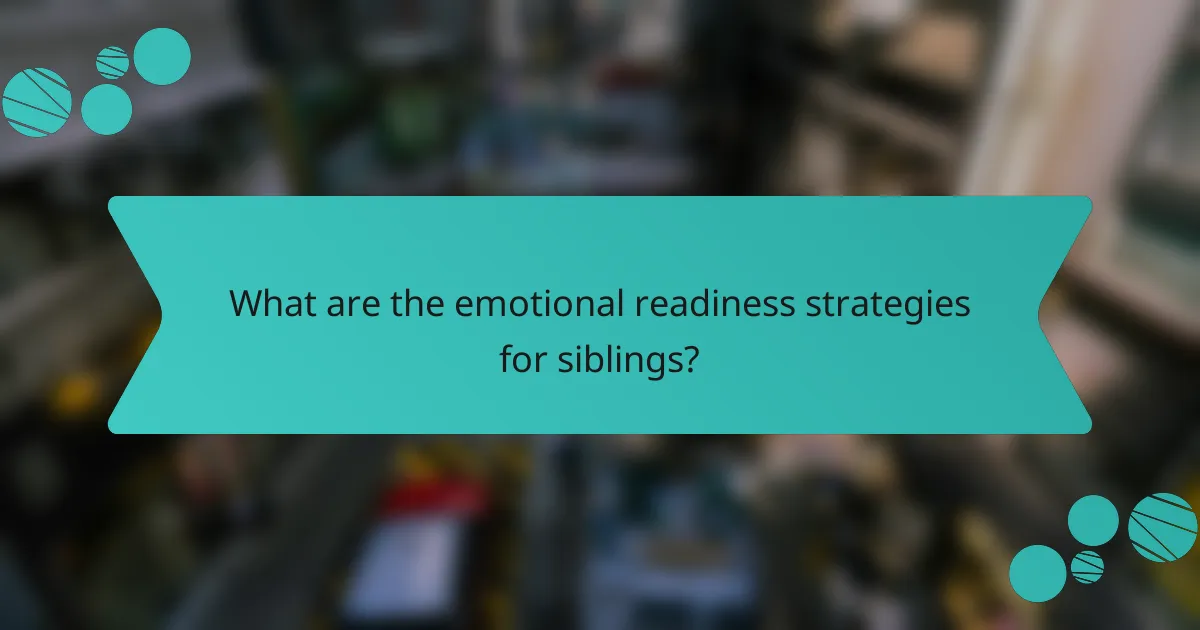Sibling preparation classes play a vital role in enhancing family dynamics by helping children adjust to the arrival of a new sibling. These classes focus on fostering inclusion, clarifying sibling roles, and promoting emotional readiness, ensuring a smoother transition for the entire family.

How can sibling preparation classes benefit families in Los Angeles?
Sibling preparation classes in Los Angeles can significantly enhance family dynamics by equipping siblings with the tools they need to adapt to a new family member. These classes focus on fostering inclusion, defining sibling roles, and improving emotional readiness, making the transition smoother for everyone involved.
Enhance family inclusion
Sibling preparation classes promote family inclusion by actively engaging older siblings in the process of welcoming a new baby. By participating in discussions and activities, siblings learn to express their feelings and understand their role in the family unit.
Classes often include interactive sessions where siblings can share their thoughts and ask questions, creating an environment of openness. This helps to reduce feelings of jealousy or exclusion that may arise when a new child arrives.
Foster sibling roles
These classes help clarify the roles siblings will play, encouraging them to see themselves as important contributors to the family. By discussing what it means to be a big brother or sister, children can develop a sense of responsibility and pride in their new position.
Activities may include role-playing scenarios where siblings practice helping with tasks like feeding or playing with the baby. This hands-on approach reinforces their new responsibilities and strengthens their bond with the newborn.
Improve emotional readiness
Improving emotional readiness is a key focus of sibling preparation classes, as they equip children with coping strategies for the changes ahead. By addressing common feelings such as excitement, anxiety, or fear, these classes help siblings process their emotions in a supportive setting.
Instructors often provide tools like storytelling or art projects to help siblings express their feelings. This proactive approach encourages emotional resilience, making it easier for children to adjust to their evolving family dynamics.

What topics are covered in sibling preparation classes?
Sibling preparation classes cover essential topics that help children understand their new roles and emotions as they welcome a sibling. These classes focus on family inclusion, emotional readiness, and practical engagement strategies to ease the transition.
Understanding new sibling dynamics
Understanding new sibling dynamics is crucial for helping children adjust to their changing family structure. These classes explain the roles siblings will play, emphasizing that each child has a unique place in the family. Discussions often include how relationships may evolve and the importance of cooperation and support.
Children learn about the different emotions they might experience, such as jealousy or excitement, and how these feelings are normal. This understanding fosters empathy and helps siblings bond early on.
Managing emotions and expectations
Managing emotions and expectations is a key focus in sibling preparation classes. Children are guided on how to express their feelings about the new arrival, whether positive or negative. Role-playing scenarios can help them articulate their thoughts and fears in a safe environment.
Classes often provide strategies for coping with changes, such as setting realistic expectations about how much attention the new baby will require. Parents are encouraged to involve siblings in preparations, which can help mitigate feelings of exclusion.
Practical activities for engagement
Practical activities for engagement are designed to involve siblings in the process of welcoming a new baby. These can include creating a “big sibling” book, where children can draw or write about their feelings and expectations. Such activities help children feel included and valued in the family dynamic.
Additionally, classes may introduce hands-on tasks like helping to set up the nursery or choosing baby clothes. This involvement not only prepares them for their new role but also strengthens their bond with the baby before birth.

How to choose the right sibling preparation class?
Choosing the right sibling preparation class involves evaluating the class’s structure, instructor qualifications, and the overall environment. A well-structured class will effectively prepare siblings for their new roles and help them emotionally adjust to the changes in the family dynamic.
Evaluate class structure and content
When assessing the structure and content of a sibling preparation class, consider the topics covered and the methods used to engage children. Classes should include discussions about the new baby’s arrival, sibling roles, and ways to express feelings. Look for programs that incorporate interactive activities, such as role-playing or storytelling, to make the experience relatable and enjoyable.
Additionally, check if the class is tailored to the age range of your children. Classes designed for toddlers may focus more on simple concepts, while those for older siblings can delve into more complex emotions and responsibilities.
Consider instructor qualifications
The qualifications of the instructor can significantly impact the effectiveness of a sibling preparation class. Look for instructors with backgrounds in child development, psychology, or education, as they will have a better understanding of how to communicate with children. Experience in family dynamics or prenatal education can also be beneficial.
It may be helpful to read reviews or ask for recommendations from other parents to gauge the instructor’s ability to connect with children and facilitate discussions about sensitive topics.
Assess class size and environment
The size of the class and the environment in which it is held can influence how comfortable your child feels. Smaller classes often allow for more personalized attention and interaction, which can enhance the learning experience. Aim for a class size that allows for meaningful engagement, ideally no more than 8-10 children.
Additionally, consider the physical environment. A welcoming and child-friendly space can help children feel at ease. Look for classes held in community centers, libraries, or family-oriented facilities that provide a safe and inviting atmosphere for learning.

What are the emotional readiness strategies for siblings?
Emotional readiness strategies for siblings involve preparing them for the changes that come with a new family member. These strategies help siblings understand their roles, express their feelings, and foster healthy relationships within the family.
Encouraging open communication
Open communication is crucial for siblings to express their thoughts and feelings about the new addition to the family. Parents can create a safe space for discussions by regularly checking in with siblings and encouraging them to share their concerns or excitement.
Using age-appropriate language, parents can explain what to expect and invite questions. This approach helps siblings feel valued and included, reducing anxiety and fostering a sense of belonging.
Practicing empathy and support
Practicing empathy allows siblings to understand and relate to each other’s feelings during this transition. Parents can model empathetic behavior by acknowledging their children’s emotions and encouraging them to consider how their sibling might feel.
Engaging in activities that promote teamwork, such as preparing for the new baby together, can strengthen sibling bonds. Additionally, parents should remind siblings that their feelings are valid and that it’s okay to seek support from each other during this time of change.

What are the sibling roles during the transition?
During the transition to welcoming a new sibling, existing children often take on various roles that help them adjust to the changes in family dynamics. These roles can include being supportive companions, helpers in daily routines, and emotional confidants, each contributing to a smoother adjustment for both the new sibling and themselves.
Supportive companions
As supportive companions, siblings can provide comfort and companionship to the new baby and their parents. This role may involve simple activities like playing together, reading stories, or engaging in family outings, which help foster a bond between siblings early on.
Encouraging siblings to participate in activities with the new baby can enhance their sense of involvement. For example, allowing them to choose a toy for the baby or help with bath time can make them feel included and valued.
Helpers in daily routines
Siblings can play a crucial role as helpers in daily routines, assisting parents with tasks related to the new baby. This might include fetching diapers, helping with feeding, or even entertaining the baby while parents attend to other responsibilities.
Involving siblings in these routines not only lightens the load for parents but also teaches children responsibility and teamwork. Establishing a simple checklist of tasks they can help with can make this process more structured and engaging.
Emotional confidants
As emotional confidants, siblings often provide a unique support system for each other during this transition. They can share their feelings about the changes in the family, offering a safe space for expressing excitement, anxiety, or jealousy.
Encouraging open communication between siblings is essential. Parents can facilitate this by regularly checking in with both the new baby and the older sibling, ensuring that everyone feels heard and understood. This practice can strengthen their emotional bond and help them navigate their feelings together.
